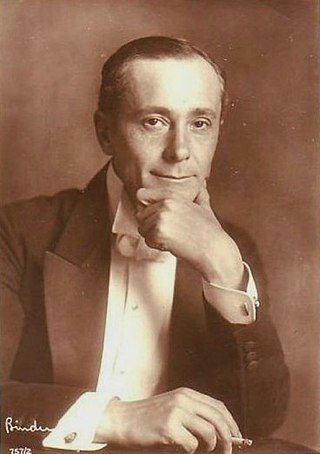
The film industry in Germany can be traced back to the late 19th century. German cinema made major technical and artistic contributions to early film, broadcasting and television technology. Babelsberg became a household synonym for the early 20th century film industry in Europe, similar to Hollywood later. Early German and German-speaking filmmakers and actors heavily contributed to early Hollywood.

Nosferatu: A Symphony of Horror is a 1922 silent German Expressionist vampire film directed by F. W. Murnau and starring Max Schreck as Count Orlok, a vampire who preys on the wife of his estate agent and brings the plague to their town.

"Silent Night" is a popular Christmas carol, composed in 1818 by Franz Xaver Gruber to lyrics by Joseph Mohr in Oberndorf bei Salzburg, Austria. It was declared an intangible cultural heritage by UNESCO in 2011. The song was first recorded in 1905 and has remained a popular success, appearing in films and multiple successful recordings, as well as being quoted in other musical compositions. It is the world's most recorded Christmas song, with more than 137,000 known recordings.
1917 in film was a particularly fruitful year for the art form, and is often cited as one of the years in the decade which contributed to the medium the most, along with 1913. Secondarily the year saw a limited global embrace of narrative film-making and featured innovative techniques such as continuity cutting. Primarily, the year is an American landmark, as 1917 is the first year where the narrative and visual style is typified as "Classical Hollywood".
The following is an overview of the events of 1895 in film, including a list of films released and notable births.
The following is an overview of the events of 1892 in film, including a list of films released and notable births.

A flip book, flipbook, flicker book, or kineograph is a booklet with a series of images that very gradually change from one page to the next, so that when the pages are viewed in quick succession, the images appear to animate by simulating motion or some other change. Often, flip books are illustrated books for children, but may also be geared toward adults and employ a series of photographs rather than drawings. Flip books are not always separate books, but may appear as an added feature in ordinary books or magazines, frequently using the page corners. Software packages and websites are also available that convert digital video files into custom-made flip books.

Max Skladanowsky was a German inventor and early filmmaker. Along with his brother Emil, he invented the Bioscop, an early movie projector the Skladanowsky brothers used to display a moving picture show to a paying audience on 1 November 1895, shortly before the public debut of the Lumière Brothers' Cinématographe in Paris on 28 December 1895.
The German Film Orchestra Babelsberg is a symphony orchestra and music studio based in Potsdam, Germany.

Guido Seeber was a German cinematographer and pioneer of early cinema.

Bauerntanz zweier Kinder, also known as Italienischer Bauerntanz or Italian folk dance, is an 1895 German short black-and-white silent documentary film directed by Max Skladanowsky. The film captures two children, Ploetz and Lorella, performing a dance.

Boxing Kangaroo is an 1895 German short black-and-white silent documentary film, directed and produced by Max Skladanowsky, which features a kangaroo boxing against a man against a white background at the Circus Busch. The film, which premiered at the first public projection of motion pictures in Germany on 1 November 1895, was filmed on 35 mm film and is 18 feet in length.

Die Serpentintänzerin is an 1895 German short black-and-white silent documentary film, directed and produced by Max Skladanowsky, one of the German-born brothers responsible for inventing the Bioscop.

Alfred Peter Abel was a German film actor, director, and producer. He appeared in more than 140 silent and sound films between 1913 and 1938. His best-known performance was as Joh Fredersen in Fritz Lang's 1927 film Metropolis.

The Boxing Kangaroo is an 1896 British short black-and-white silent documentary film, produced and directed by Birt Acres for exhibition on Robert W. Paul's peep show Kinetoscopes, featuring a young boy boxing with a kangaroo. The film was considered lost until footage from an 1896 Fairground Programme, originally shown in a portable booth at Hull Fair by Midlands photographer George Williams, donated to the National Fairground Archive was identified as being from this film.

A film, also known as a movie, is a work of visual art that simulates experiences and otherwise communicates ideas, stories, perceptions, emotions, or atmosphere through the use of moving images that are generally accompanied by sound and other sensory stimulations. The word "cinema" is a shortening of the word "cinematography" and is used to refer to either filmmaking, the film industry, the overall art form, or a movie theater.
The Bioscop is a movie projector developed in 1895 by German inventors and filmmakers Max Skladanowsky and his brother Emil Skladanowsky (1866–1945).

A Trick of the Light is a 1995 German biographical film directed by Wim Wenders. The film was made with the students of the University of Television and Film Munich and is a combination of docudrama, fictional reenactment, and experimental photography to show the birth of cinema in Berlin where Max Skladanowsky and his brother Emil built a projector they called the Bioscop.

The wordless novel is a narrative genre that uses sequences of captionless pictures to tell a story. As artists have often made such books using woodcut and other relief printing techniques, the terms woodcut novel or novel in woodcuts are also used. The genre flourished primarily in the 1920s and 1930s and was most popular in Germany.
Events in 1863 in animation.














